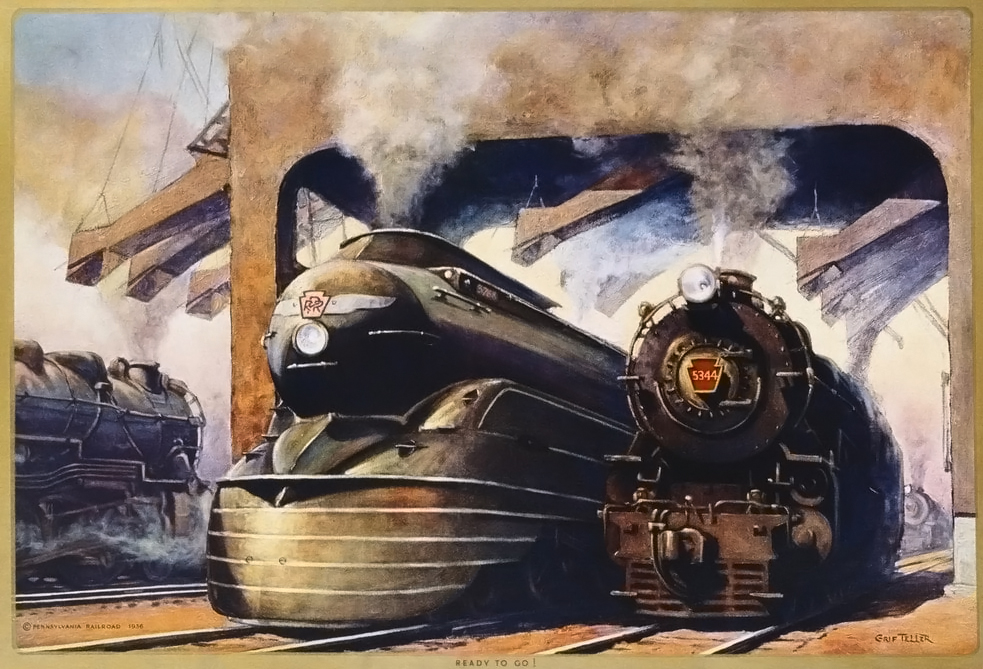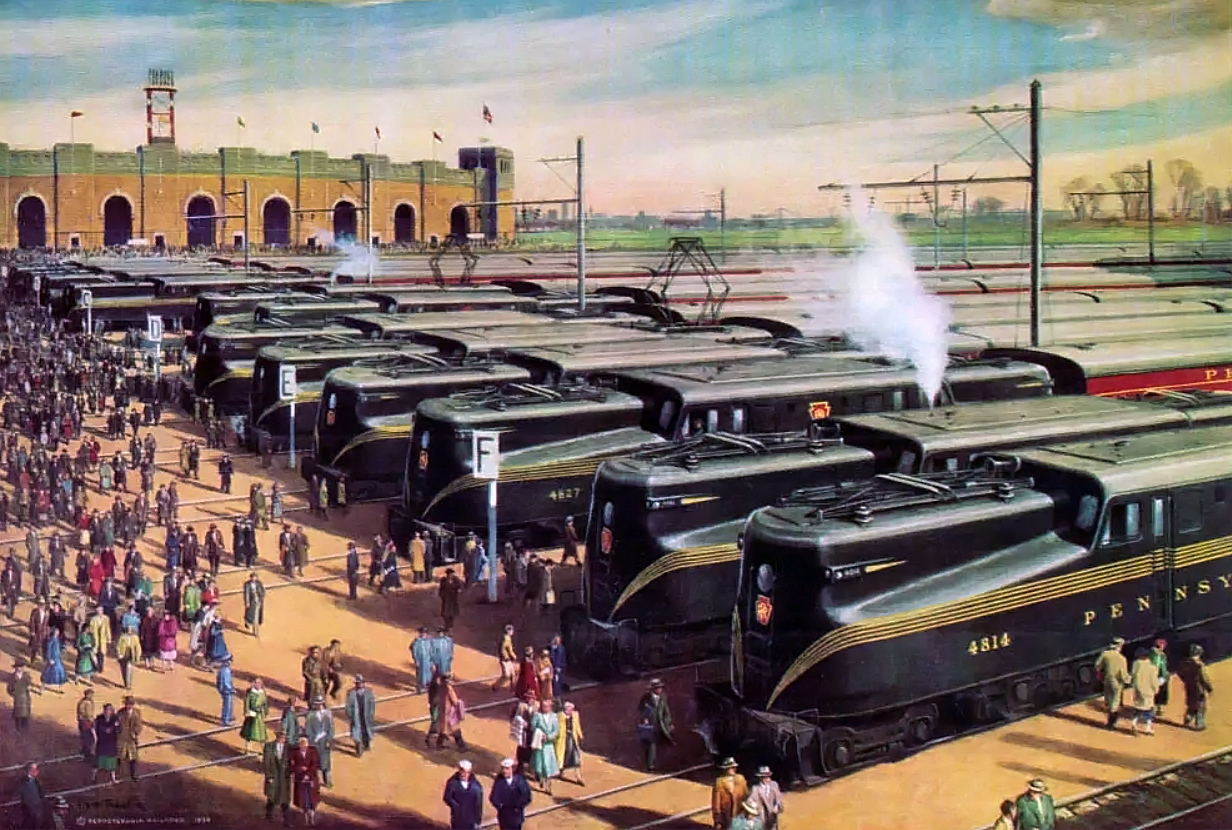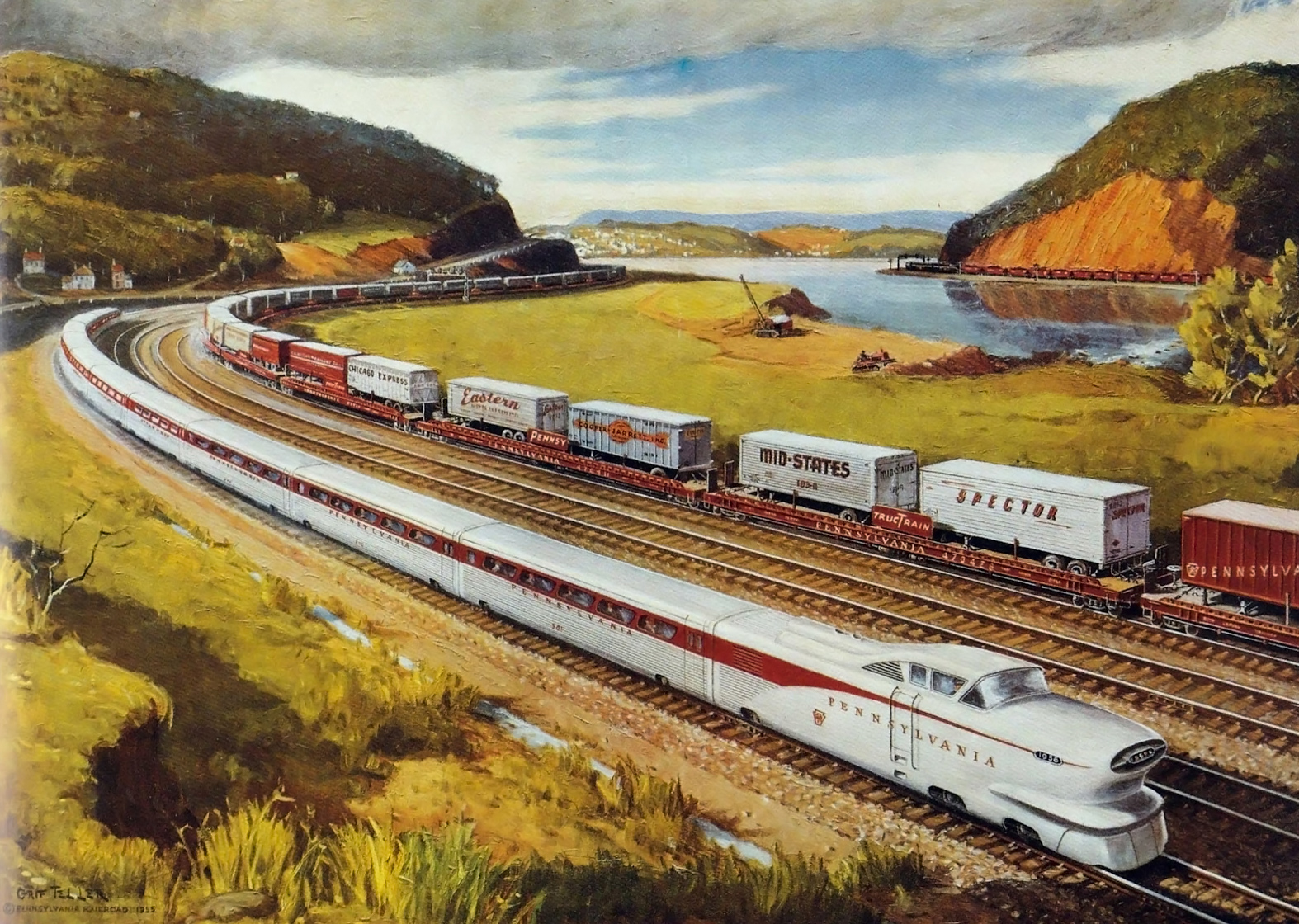The Life and Work of Grif Teller: The PRR's Canvas Maestro
Published: July 25, 2024
By: Adam Burns
In the annals of American art and railway history, few names echo with the resonance of Grif Teller.
Celebrated for his captivating railroad paintings, Teller's works have become iconic representations of the golden era of railroading, transporting viewers back to a time when the railways were arteries of American development and innovation.
This article delves into the life and contributions of Grif Teller, better known as the artist often commissioned by the Pennsylvania Railroad, exploring his journey, influences, and legacy within the art world and rail transport industry.
 "Ready to Go!" Artrwork by Grif Teller, featuring one of PRR's streamlined 4-6-2s (#3768) for the Broadway Limited in 1936, alongside 4-6-2 #5344.
"Ready to Go!" Artrwork by Grif Teller, featuring one of PRR's streamlined 4-6-2s (#3768) for the Broadway Limited in 1936, alongside 4-6-2 #5344.Early Life and Education
Born on December 9, 1899, in Newark, New Jersey, Grif Teller exhibited artistic talent from an early age. His inclination towards art was nurtured by supportive parents who recognized his potential.
Following his primary education, Teller enrolled at the Fawcett School of Industrial Arts, which later became the Newark School of Fine and Industrial Arts. Here, he received a formal education in commercial art, blending rigorous training with a flair for visual storytelling.
Career Beginnings
Teller's early career saw him take on various roles in commercial art, showcasing his versatility and honing his skills across different mediums. It was during this period that Teller's path crossed with the Pennsylvania Railroad (PRR), a collaboration that would define much of his professional life.
The Pennsylvania Railroad, one of the most significant rail networks in the United States, sought to use art as a means of promoting its services and capturing the imagination of the American public. Teller's detailed, evocative style made him the perfect candidate for this mission.
Collaboration with the Pennsylvania Railroad
Grif Teller's relationship with the Pennsylvania Railroad began in 1928 when he completed a wall calendar scene for the company.
, marking the start of a prolific partnership that spanned several decades.
The PRR commissioned Teller to create a series of calendar paintings, which would become annual keepsakes for employees, clients, and rail enthusiasts. These calendars provided a platform for Teller to blend his artistic vision with the grandeur and technological marvel of the railroad industry.
Teller's paintings for the PRR are characterized by their meticulous attention to detail and dramatic use of light and shadow.
His works often depicted locomotives in action, dynamic landscapes, and bustling urban settings, capturing the essence of the railway's contribution to American progress.
The paintings were not just promotional tools but also works of art that conveyed the energy, speed, and strength of the trains, alongside the beauty of the American landscape.
 "When The Broad Way Meets The Dawn." Artwork by Grif Teller, featuring the PRR's 1928, pre-streamlined Broadway Limited.
"When The Broad Way Meets The Dawn." Artwork by Grif Teller, featuring the PRR's 1928, pre-streamlined Broadway Limited.Signature Works
Among Teller's many notable works for the Pennsylvania Railroad, a few stand out for their artistic and historical significance. One such painting is the 1952 calendar piece titled "The Horseshoe Curve," which portrays the Horseshoe Curve near Altoona, Pennsylvania.
This engineering marvel, a curve of tracks on a mountainside, is shown bustling with locomotives, symbolizing the vital role of the railroads in post-war American commerce and industry.
Another remarkable work is "Main Lines - Freight And Passenger," the 1949 calendar painting. This piece captures the juxtaposition of past and present by showcasing a modern GG-1 electric locomotive passing beneath a steam-powered freight train, illustrating the transition in rail technology and engineering prowess.
There were many others, such as those presented within this article. Also of note is the book, "Crossroads of Commerce: The Pennsylvania Railroad Art of Grif Teller" released in 2003 by Dan Cupper and Ken Mury and features much of the artist's work.
Teller's ability to encapsulate such pivotal moments in rail history made his works not only visually stunning but also contextually rich.
 "Mass Transportation." Artwork by Grif Teller, featured in PRR's 1955 calendar. This lineup of GG1s was a common scene at Philadelphia's old Municipal Stadium for the annual Army-Navy Game.
"Mass Transportation." Artwork by Grif Teller, featured in PRR's 1955 calendar. This lineup of GG1s was a common scene at Philadelphia's old Municipal Stadium for the annual Army-Navy Game.Artistic Influence and Style
Grif Teller's art is often noted for its realist approach, a style that seeks to represent subjects as they appear in everyday life, with a particular emphasis on accuracy and detail.
His works are imbued with a sense of narrative, where each painting tells a story beyond its immediate visual appeal. Teller's technique involved extensive research and on-site studies; he meticulously gathered visual information to ensure the authenticity of his depictions.
The influence of American landscape painters, such as the Hudson River School artists, is evident in Teller's handling of vast, dramatic environments.
However, Teller distinguished himself by integrating industrial elements into these natural settings, creating a unique harmony between human achievement and the natural world. His paintings often evoke a sense of movement and progress, reflecting the technological optimism of the early to mid-20th century.
Legacy and Impact
Grif Teller's contributions to the Pennsylvania Railroad and the broader field of American art are enduring. His works not only served as promotional materials but also as historical records that document the evolution of the railway industry.
The calendars became cherished items, passed down through generations and appreciated by collectors and historians alike. Teller's ability to capture the spirit of an era and the essence of rail travel has cemented his legacy as a pivotal figure in the intersection of art and industrial history.
Beyond his work with the PRR, Teller’s influence extended into other areas of commercial art, though it is his railroad paintings that remain most celebrated.
His works are featured in museums, galleries, and private collections, continuing to inspire admiration and interest. Exhibitions of Teller’s art offer viewers a glimpse into the past, where each painting serves as a window into the transformative power of the railways on the American landscape and society.
 "Dynamic Progress." Artwork by Grif Teller, featured in the PRR's 1956 calendar. Ironically the railroad never purchased GM's failed "Aerotrain" concept (pictured) although it did extensively test the trainset. Also note the freight train of truck trailers - or "TrucTrain" as the PRR called their service - which was a relatively new concept in the industry at the time.
"Dynamic Progress." Artwork by Grif Teller, featured in the PRR's 1956 calendar. Ironically the railroad never purchased GM's failed "Aerotrain" concept (pictured) although it did extensively test the trainset. Also note the freight train of truck trailers - or "TrucTrain" as the PRR called their service - which was a relatively new concept in the industry at the time.Conclusion
Grif Teller's life and work stand as a testament to the power of art in capturing and preserving the essence of human achievement and technological progress.
His meticulous and evocative paintings for the Pennsylvania Railroad not only promoted the railways but also immortalized a crucial chapter in American history.
As we look back on Teller's contributions, we are reminded of the indelible mark he left on both the art world and the railroad industry—a legacy that continues to steam ahead, much like the trains he so brilliantly brought to life on canvas.
Recent Articles
-
Minnesota - Murder Mystery - Dinner Train Rides
Dec 27, 25 03:50 PM
Murder mystery dinner trains offer an enticing blend of suspense, culinary delight, and perpetual motion, where passengers become both detectives and dining companions on an unforgettable journey. -
Georgia - Murder Mystery - Dinner Train Rides
Dec 27, 25 03:35 PM
In the heart of the Peach State, a unique form of entertainment combines the thrill of a murder mystery with the charm of a historic train ride. -
New Jersey - Wine Tasting - Train Rides
Dec 27, 25 09:57 AM
If you're seeking a unique outing or a memorable way to celebrate a special occasion, wine tasting train rides in New Jersey offer an experience unlike any other.



